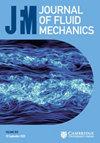扩散对多孔介质中水动力分散和过滤的影响
IF 3.6
2区 工程技术
Q1 MECHANICS
引用次数: 0
摘要
众所周知,胶体颗粒在多孔介质中的分散是由介质结构、孔隙尺度流动变化和扩散决定的。然而,人们对扩散oresis(即胶体粒子沿盐梯度的运动)如何影响多孔介质中的大规模粒子分散却知之甚少。为了揭示这个问题,我们对二维超均匀多孔介质中的流体流动、溶质传输和粒子扩散泳移进行了详细的孔隙尺度模拟。粒子和溶质最初均匀分布在整个介质中。以恒定流速冲洗介质,并在出口处记录颗粒突破曲线,以评估扩散泳的宏观效应。粒子突破曲线显示出非费克式行为,表现为受扩散流动性控制的强烈拖尾。尽管由于盐梯度的快速衰减,衍射导流是一种短时间的微观现象,但它通过将颗粒划分为透射孔和末端孔来控制宏观胶体分散。我们通过一个放大的分析模型来量化这些行为,该模型同时描述了胶体在末端孔隙中的滞留和释放以及观察到的长时间尾流。我们的研究结果表明,扩散泳是控制颗粒在多孔介质中的分散和过滤的有效工具。本文章由计算机程序翻译,如有差异,请以英文原文为准。
The impact of diffusiophoresis on hydrodynamic dispersion and filtration in porous media
It is known that the dispersion of colloidal particles in porous media is determined by medium structure, pore-scale flow variability and diffusion. However, much less is known about how diffusiophoresis, that is, the motion of colloidal particles along salt gradients, impacts large-scale particle dispersion in porous media. To shed light on this question, we perform detailed pore-scale simulations of fluid flow, solute transport and diffusiophoretic particle transport in a two-dimensional hyper-uniform porous medium. Particles and solute are initially uniformly distributed throughout the medium. The medium is flushed at constant flow rate, and particle breakthrough curves are recorded at the outlet to assess the macroscopic effects of diffusiophoresis. Particle breakthrough curves show non-Fickian behaviour manifested by strong tailing that is controlled by the diffusiophoretic mobility. Although diffusiophoresis is a short-time, microscopic phenomenon owing to the fast attenuation of salt gradients, it governs macroscopic colloid dispersion through the partitioning of particles into transmitting and dead-end pores. We quantify these behaviours by an upscaled analytical model that describes both the retention and release of colloids in dead-end pores and the observed long-time tailings. Our results suggest that diffusiophoresis is an efficient tool to control particle dispersion and filtration through porous media.
求助全文
通过发布文献求助,成功后即可免费获取论文全文。
去求助
来源期刊
CiteScore
6.50
自引率
27.00%
发文量
945
审稿时长
5.1 months
期刊介绍:
Journal of Fluid Mechanics is the leading international journal in the field and is essential reading for all those concerned with developments in fluid mechanics. It publishes authoritative articles covering theoretical, computational and experimental investigations of all aspects of the mechanics of fluids. Each issue contains papers on both the fundamental aspects of fluid mechanics, and their applications to other fields such as aeronautics, astrophysics, biology, chemical and mechanical engineering, hydraulics, meteorology, oceanography, geology, acoustics and combustion.

 求助内容:
求助内容: 应助结果提醒方式:
应助结果提醒方式:


